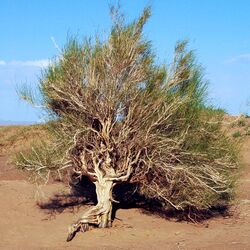Biology:Haloxylon
| Haloxylon | |
|---|---|

| |
| Haloxylon ammodendron | |
| Scientific classification Error creating thumbnail: Unable to save thumbnail to destination
| |
| Kingdom: | Plantae |
| Clade: | Tracheophytes |
| Clade: | Angiosperms |
| Clade: | Eudicots |
| Order: | Caryophyllales |
| Family: | Amaranthaceae |
| Subfamily: | Salsoloideae |
| Tribe: | Salsoleae |
| Genus: | Haloxylon Bunge ex Fenzl |
| Species | |
Haloxylon is a genus of shrubs or small trees, belonging to the plant family Amaranthaceae. Haloxylon and its species are known by the common name saxaul. According to Dmitry Ushakov, the name borrowed from the Kazakh "seksevil". In modern Kazakh language, the shrub is called "seksewil".
Description
The species of genus Haloxylon are shrubs or small trees 1–8 metres (3 1⁄2–26 feet) (rarely up to 12 m or 39 ft) tall, with a thick trunk and many branches. The branches of the current year are green, from erect to pendant. The leaves are reduced to small scales. The inflorescences are short shoots borne on the stems of the previous year. The flowers are very small, as long or shorter than the bracteoles, bisexual or male. The two stigmas are very short. In fruit, the perianth segments develop spreading wings. The fruit with wings is about 8 millimetres (1⁄4 in) in diameter. The seed is about 1.5 mm (1⁄16 in) in diameter.[1]
Distribution and habitat
The genus Haloxylon is distributed in southwest and Central Asia, from Egypt to Mongolia and China (Xinjiang and Gansu), where it grows in sandy habitats (psammophyte).[1]
Taxonomy
The genus name Haloxylon was published by Alexander Bunge (ex Eduard Fenzl) in 1851, with the type species Haloxylon ammodendron.
The genus belongs to the subfamily Salsoloideae in the family Amaranthaceae, It consists of only two species:[2]
- Haloxylon ammodendron (C.A.Mey.) Bunge ex Fenzl. (Synonym: Haloxylon aphyllum[3]) – black saxaul
- Haloxylon persicum Bunge ex Boiss. – white saxaul
Phylogenetic research revealed that several species formerly included in Haloxylon are not related to this genus. They are now classified to genus Hammada, with exception of the former Haloxylon stocksii (syn. Haloxylon recurvum), which has been moved to Salsola stocksii.[2]
The common name saxaul, sometimes sacsaoul or saksaul, comes from the Russian саксаул (saksaul), which is from Kazakh сексеуiл (seksewil).
Ecology
In the deserts of Central Asia, a large number of birds are associated with saxaul, including the saxaul sparrow.[4]
Uses
In the former bed of the Aral Sea, saxaul trees are being planted to stop the wind picking up contaminated sand from the dried up sea bed and spreading them through the atmosphere. The plan is to cover the entire former bed with a forest.[5]
References
- ↑ 1.0 1.1 Hedge, I. C. (1997). "Haloxylon". in Rechinger, Karl Heinz. Flora Iranica Bd. 172, Chenopodiaceae. Graz: Akad. Druck. pp. 315–326. ISBN 3-201-00728-5.
- ↑ 2.0 2.1 Akhani, Hossein; Edward, Gerald; Roalson, Eric H. (2007). "Diversification of the Old World Salsoleae S.L. (Chenopodiaceae): Molecular Phylogenetic Analysis of Nuclear and Chloroplast Data Sets and a Revised Classification". International Journal of Plant Sciences 168 (6): 931–956. doi:10.1086/518263.
- ↑ Tropicos
- ↑ Maclean, Gordon Lindsay (1996). "Avian adaptations to deserts of the Northern and Southern hemispheres: a comparison". Curtin University of Technology School of Environmental Biology Bulletin (17). http://espace.lis.curtin.edu.au/archive/00000320/01/Bulletin_17.pdf. Retrieved 2010-02-16.
- ↑ Qobil, Rustam (31 May 2018). "Restoring life to the Aral Sea's dead zone". BBC News. https://www.bbc.com/news/business-44159122.
- Pyankov, Vladimir I.; Black, Clanton C. Jr.; Artyusheva, Elena G.; Voznesenskaya, Elena V.; Ku, Maurice S.B.; Edwards, Gerald E. (1999). "Features of Photosynthesis in Haloxylon species of Chenopodiaceae that are Dominant Plants in Central Asian Deserts". Plant and Cell Physiology 40 (2): 125–134. doi:10.1093/oxfordjournals.pcp.a029519.
External links
Wikidata ☰ Q268179 entry
 |

